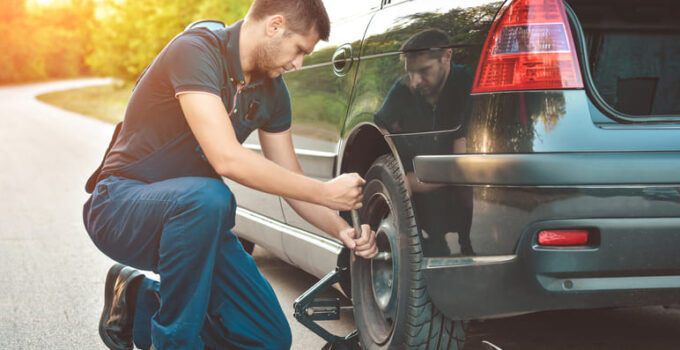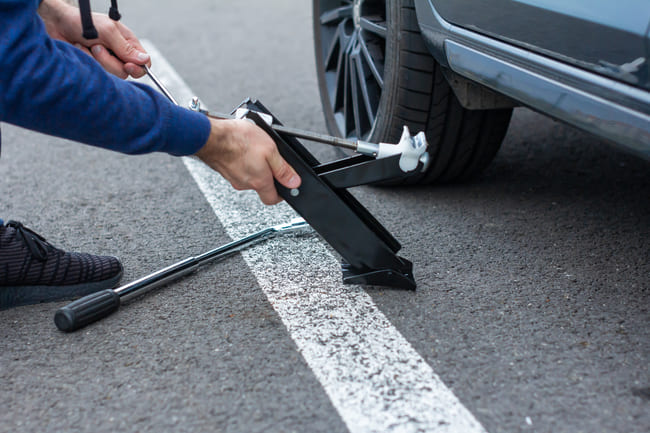
If you get the right tool for changing tires, you save you permanently. A suitable jack and a torque wrench or a wheel spider or wheel wrench are sufficient. You can purchase this accessory once for a small amount of money. Then you simply change the tire and store it yourself.
Contents
When should you change the tyre

A tire change is not only necessary at regular intervals (in spring and autumn), but also whenever one of your tires has failed. Then you have to exchange it for your spare wheel, usually under difficult conditions at the edge of the road.
Speaking of wheels: It is correct to change the wheel twice a year, because the summer tires or winter tires usually remain on the corresponding rims. On the other hand, one speaks of a tire change when only the tire is actually replaced on the same rim. In this text, for the sake of simplicity, we will keep the commonly used term „tire change“ at.
Preparations for your tire change
Before you even mount the tires for the new winter or summer season, you should first make sure you are well prepared. Studying this article is of course a good first step.

In addition, you should also check whether the wheels you want to mount are in order. Check them for stones, nails and damage – both in the tread and on the edge. In addition, the tires must also have sufficient profile. It is 3 to 4 millimeters to be really safe on the road. For the sake of completeness, it should be pointed out that in The United Kingdom only 1.6 mm is required by law, but many car insurance companies are already demanding higher tread depths. In addition, you should also consult the technical operating instructions for your car to find out where you can place your jack. The same applies to the torque required for the wheel bolts when changing tires.
Also note that when you change tires from aluminum to steel rims, you also need different wheel bolts. This is because the two types of rims have different thicknesses and strengths due to the material.
The instructions to change the tires yourself
The first thing you should do when changing tires is to apply the handbrake. If you drive a car with an automatic transmission, set the selector lever to the „P“ position. Then decide on a wheel that you want to change first. First, remove any existing wheel cover and loosen the wheel bolts or wheel nuts slightly (only a quarter of a turn). Then raise your car with the jack (be sure to follow the instructions in the manual regarding the position of the jack).

Now you can loosen all the wheel bolts one after the other. Screws on opposite sides are always loosened one after the other. Now remove the wheel and clean the corresponding wheel contact surface before installing the new wheel.
Now attach the change wheel. You have to pay attention to the direction of rotation (the preferred direction of rotation is marked with an arrow on the side of the tire). In addition, some experts recommend to mount the wheels, which were previously mounted on the rear axle, on the front axle and vice versa. This achieves more even tire wear. Then follow the sequence given in the owner’s manual to screw in the wheel bolts. First, these are screwed in loosely before they are then hand-tightened. The next step is to lower your car so far that your bike is just standing up. The wheel bolts can now be tightened to the prescribed torque. Now move on to the next wheel. The total time for a tire change is 30 to 60 minutes.
You should know that the screws are properly tightened after about 50 to 100check kilometers again. It is now advisable to mark the mounting position of the removed tires with wax crayon. You can use the common abbreviations „VL“, „VR“, „HL“ and „HR“ (front left, front right, rear left and rear right); so that you know which tire goes where the next time you change tires. Then drive your car straight to the tire pressure check (it’s even better if you have your own compressor or a suitable air pump at home).

How do you store the wheels until the next tire change
Dry, dark and cool storage, preferably in a well-ventilated basement, is ideal if you want to maximize tire life. In particular, protection against dirt, oil, solar radiation and solvents is particularly important. Before storing, increase the air pressure a little so that they still have enough air for the trip to the gas station the next time they are assembled. Complete wheels can either be attached to the appropriate wall brackets or on a rim tree or carefully stacked on top of each other with a protection between the wheels. If, on the other hand, you store tires without rims, they should be stored upright and turned by about 90 ° every 1-2 months.
Conclusion
Changing a tire is not difficult. As long as you follow our instructions, not much can actually happen. In addition, however, you need a suitable storage area and enough storage space to keep the tires safe for the rest of the year. If you notice unusual noises after changing tires or even the steering wheel wobbling at certain speeds, the tires probably need to be rebalanced. Either a tire dealer or a specialist workshop can help you with this.
A tip from CarTipsandmore: In order not to miss a tire change, you can stick to the following general rule: summer tires can be used from about Easter to October; after that winter tires are used again. This is mainly due to the fact that winter tires have better road grip even at single-digit temperatures.
